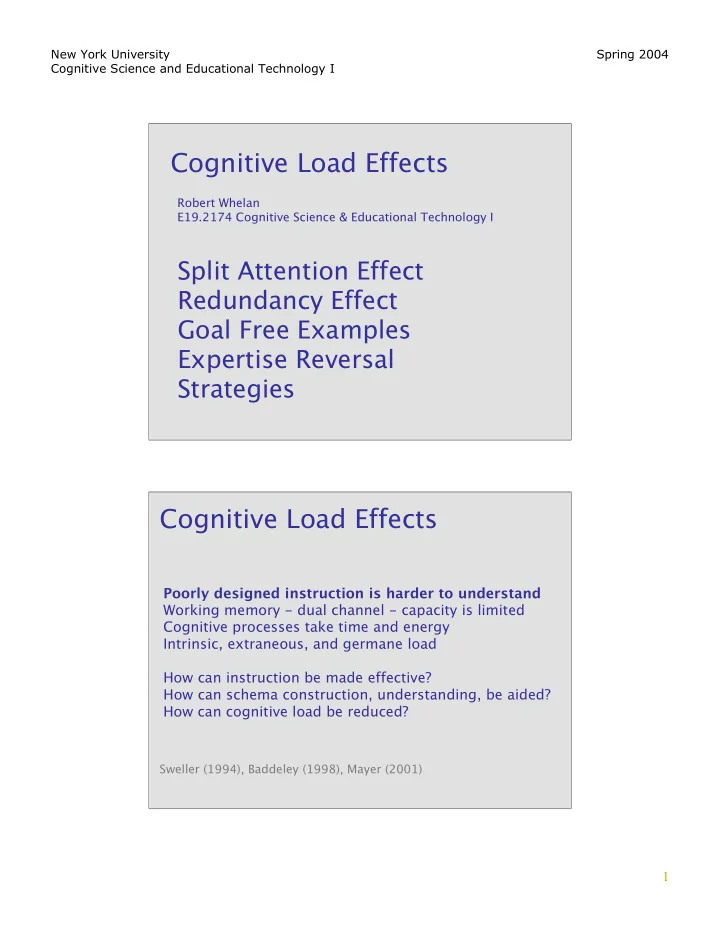

New York University Spring 2004 Cognitive Science and Educational Technology I Cognitive Load Effects Robert Whelan E19.2174 Cognitive Science & Educational Technology I Split Attention Effect Redundancy Effect Goal Free Examples Expertise Reversal Strategies Cognitive Load Effects Poorly designed instruction is harder to understand Working memory - dual channel - capacity is limited Cognitive processes take time and energy Intrinsic, extraneous, and germane load How can instruction be made effective? How can schema construction, understanding, be aided? How can cognitive load be reduced? Sweller (1994), Baddeley (1998), Mayer (2001) 1
New York University Spring 2004 Cognitive Science and Educational Technology I Split Attention Effect Integration, cross-referencing of discontiguities Sources separated in time Sources separated in space Attention is serial in complex tasks Split sources invoke processing costs Integrate, reduce redundancy, incoherence Redundancy Effect Recognizing and managing extraneous sources Use of image + text + narration (Mayer) Use of material that’s already known (Kalyuga) Additional processing required to ignore and focus Avoid extraneous sources, information Reduce incoherent material 2
New York University Spring 2004 Cognitive Science and Educational Technology I Goal Free/Worked Examples Problem-solving processes induce high load Worked examples facilitate understanding Novices prefer worked examples to problems Experts prefer problems; W.E. are redundant Means-ends analysis, subtasks tracking, operators Unrelated, high-load schema construction Tailor instruction to individual differences Modality Effect Advantage of bimodal presentation Auditory + visual versus visual-only Efficiency of narrated animations Load is spread across 2 channels Dual-channel processing increases spare capacity Reduce overload on one channel 3
New York University Spring 2004 Cognitive Science and Educational Technology I Expertise Reversal Effect Novices benefit from CLT techniques more than experts Applies to S/A, Redundancy, Modality, W.E, Contiguity Novices learn from examples -> build schemas Experts solve problems -> speed and accuracy Cognitive load, skills acquisition, changes over time Transition to expertise: Principles, operators, coherence Stages of expertise and germane load Fading: Increased blanks Strategies (Mayer & Moreno, 2003) Visual Overload Off-load to auditory channel Bimodal Overload Segmenting; Pretraining Extraneous Load Weeding; Signaling/Cues Redundancy Alignment; Avoid reproduction Discontiguities Synchronize; Spatial ability effect 4
New York University Spring 2004 Cognitive Science and Educational Technology I Conclusions Techniques can reduce S/A, redundancy, problem-solving, modality load, increase learning Load effects/techniques are often intuitively “obvious” Design for experts has more sophisticated requirements Interaction bet. CLT techniques, Expertise, Redundancy Auditory modality provides different, richer information 5
Recommend
More recommend